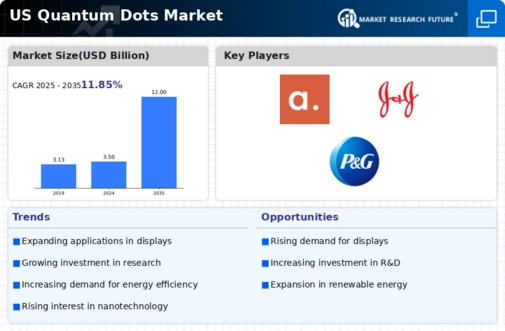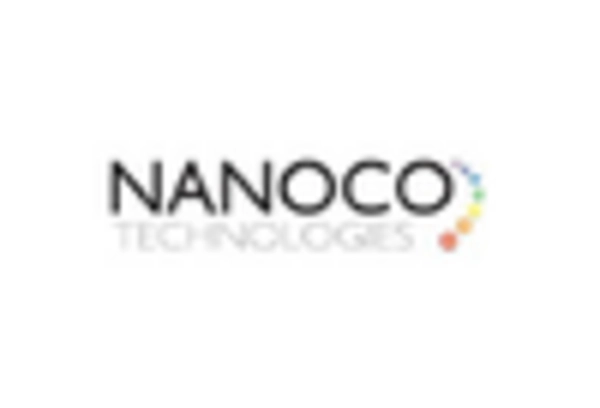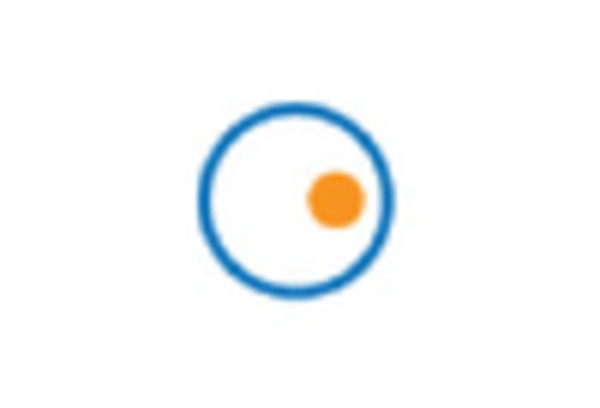Rising Adoption in Consumer Electronics
The quantum dots market is significantly influenced by the rising adoption of quantum dot technology in consumer electronics. Major manufacturers are increasingly integrating quantum dots into televisions and monitors to enhance display quality. The market for quantum dot TVs alone is expected to grow at a CAGR of 25% from 2025 to 2030, driven by consumer demand for superior visual experiences. This trend is further supported by the decreasing costs of quantum dot production, making it more accessible for manufacturers. As consumer electronics continue to evolve, the quantum dots market is poised for substantial growth, reflecting the industry's shift towards high-performance display technologies.
Advancements in Semiconductor Technology
The quantum dots market is experiencing a surge due to advancements in semiconductor technology. These innovations enhance the performance and efficiency of quantum dots, making them more appealing for various applications. For instance, the integration of quantum dots in LED displays has shown to improve color accuracy and energy efficiency. The market for quantum dot displays is projected to reach approximately $10 billion by 2026, indicating a robust growth trajectory. This growth is driven by the increasing demand for high-resolution displays in consumer electronics, which is a significant segment of the quantum dots market. As semiconductor technology continues to evolve, it is likely that the capabilities of quantum dots will expand, further solidifying their role in the market.
Regulatory Support for Advanced Materials
The quantum dots market is positively impacted by regulatory support for advanced materials. Government initiatives aimed at promoting the development and commercialization of nanotechnology are creating a favorable environment for quantum dot applications. Policies encouraging the use of advanced materials in electronics and renewable energy are likely to stimulate market growth. For instance, federal funding for nanotechnology research has increased by 15% in 2025, reflecting a commitment to fostering innovation in this field. This regulatory support not only enhances the visibility of quantum dots but also encourages collaboration between academia and industry, potentially leading to breakthroughs that could further propel the quantum dots market.
Growing Interest in Photovoltaic Applications
The quantum dots market is witnessing a growing interest in photovoltaic applications, particularly in the development of solar cells. Quantum dots have the potential to enhance the efficiency of solar energy conversion, which is crucial for meeting renewable energy targets. Recent studies suggest that incorporating quantum dots into solar cells could increase their efficiency by up to 30%. This potential has attracted significant investment, with funding for quantum dot solar technology reaching over $500 million in recent years. As the push for sustainable energy solutions intensifies, the quantum dots market is likely to benefit from increased research and development efforts aimed at optimizing these materials for solar applications.
Increased Investment in Research and Development
the quantum dots market benefits from increased investment in research and development activities. Various stakeholders, including private companies and government entities, are allocating substantial resources to explore the potential applications of quantum dots across multiple sectors. In 2025, R&D spending in the quantum dots market is estimated to exceed $1 billion, focusing on innovations in electronics, healthcare, and energy. This influx of funding is likely to accelerate the pace of technological advancements, leading to new applications and improved performance of quantum dots. As research continues to unveil the capabilities of these materials, the market is expected to expand, driven by novel applications and enhanced product offerings.
















Leave a Comment